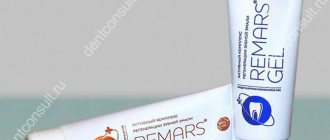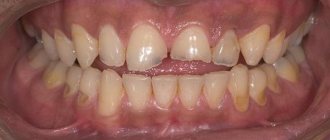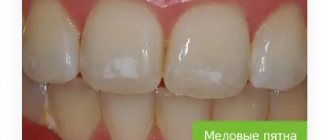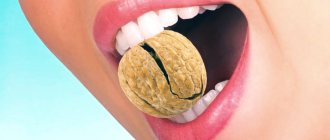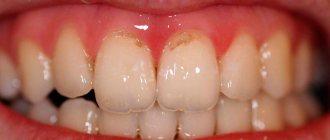Posted by Marbery Gedrean | Checked by: Shteba Victoria Petrovna | Last revised: April 15, 2022.
Tooth enamel is the hardest tissue in the human body. Lost enamel is not restored. You can try to restore it using home methods, such as diet and the use of special pastes. These products are known as liquid artificial enamel, but their effectiveness is limited. In some cases, professional intervention may be required.
Causes of destruction of the enamel layer of teeth
Enamel is a mineral layer about 2 mm thick that covers the crown of the teeth.
97% consists of a crystalline substance of hydroxyapatite with small inclusions of calcium, fluorine, magnesium, and carbon. Performs a protective function, protects dentin and pulp from external influences. This is the hardest tissue in the human body; 1 square millimeter of its area can support 397.6 kg. But, nevertheless, even such a durable material can begin to deteriorate due to exposure to physical or chemical factors. The most common causes of enamel destruction:
- accumulation of plaque due to poor hygiene;
- exposure to concentrated acids contained in natural juices and carbonated drinks;
- unbalanced diet, large amounts of carbohydrates in the daily diet;
- mechanical injuries to the tooth crown with the formation of cracks and chips;
- bad habits of chewing pens and pencils;
- bite defects;
- wearing braces;
- abnormal abrasion of the enamel layer;
- bruxism (uncontrolled teeth grinding);
- sudden changes in temperature (for example, hot coffee after ice cream);
- diseases accompanied by leaching of calcium from the body (diabetes mellitus and other pathologies of the endocrine system);
- hereditary factor;
- stomach diseases in which the absorption of calcium and phosphorus is impaired;
- metabolic destabilization;
- caries;
- periodontal diseases;
- age-related tissue nutritional disorders.
Causes
Damage to tooth enamel is caused by the following factors:
- caries: destruction is provoked by cariogenic microflora. A favorable environment for bacteria to multiply is leftover food, especially carbohydrates. After eating, a characteristic plaque appears on the teeth, which is the main cause of caries. Carious lesions are localized in the cervical region on the incisors and canines, in the interdental spaces and recesses on the surface of the molars;
- use of whitening toothpastes: often such products contain abrasive particles that effectively polish and remove plaque. However, due to excessive mechanical stress, teeth become thinner. Whitening pastes are mainly used by smokers, coffee and other drinks that can stain teeth;
- malocclusion: improper closure of the dentition causes overload of the teeth, resulting in thinning of the enamel, dull or rough spots appear, especially in the cervical area, which often leads to the development of a wedge-shaped defect;
- non-carious lesion - erosion: often found in middle-aged women. The central teeth are predominantly affected. The destruction of tooth enamel is promoted by mechanical stress, work in hazardous work, the use of medications containing ascorbic acid, regurgitation, bulimia, thyrotoxicosis;
- drinking large quantities of sweet carbonated drinks: they contain sugar, citric or phosphoric acid. In combination, these components lead to damage to the enamel. Milk teeth in children and permanent teeth in adolescents wear out more often;
- demineralization: loss of minerals and salts from the enamel. Occurs due to poor oral hygiene and insufficient consumption of healthy foods containing vitamins and minerals, especially calcium and phosphorus;
- hypoplasia: a congenital pathology of non-carious origin, characterized by partial or complete absence of enamel. Depigmented, white spots, depressions, grooves appear on the teeth, and there is increased sensitivity to cold, hot, sweet, and sour.
How to determine when it’s time to restore enamel
In order to preserve the integrity of the enamel layer as much as possible (or at least stop its destruction), it is very important not to miss the first signs of the pathological process. Its initial stages are characterized by demineralization of a local area of the tooth surface. It looks like a white, non-glossy spot. This clinical picture is called caries in the white spot stage. Another sign is the appearance of tooth sensitivity. Normally, a person does not feel the touch of the tongue on the teeth, there are no unpleasant sensations when chewing food. There is also no reaction when the teeth come into contact with cold, hot, sweet or sour foods. If any of the listed signs appear in the patient, this means that the enamel layer of his teeth has begun to gradually deteriorate. The following stages of enamel corrosion are visible to the naked eye. A local dark area forms on the surface of the tooth, then it begins to expand in area and go deeper into the dentin. These are signs of a serious defect. Correcting it will require more complex measures than when the first symptoms appear.
Important: a person cannot always independently see the stage of a white spot or a small black spot. Therefore, it is extremely important to visit your dentist for a checkup twice a year. Specialists from our network of clinics will be able to promptly detect an emerging defect and eliminate the damage with minimal intervention in the tooth structure (or without it at all). Our branches are equipped with modern equipment and instruments, including dental microscopes for diagnosis and treatment.
Methods for restoring enamel in a clinical setting
All existing professional methods for restoring tooth enamel can be divided into two broad areas:
- application of substances that slow down the processes of destruction and restore tissue by releasing the elements they contain to the tooth;
- replenishment of damaged enamel with a specialized composition.
In case of slight destruction of the enamel, special fluoride varnishes and gels come to the rescue, which the dentist applies to the surface of the tooth using an applicator. It is also possible to install a mouthguard filled with professional varnish. After some time, the mouth guard is removed and re-processed as necessary.
If tooth enamel is severely damaged, varnish alone will not do. A solution that is similar in composition to the structure of enamel helps solve the problem. That’s what they call it – artificial enamel. The substance is implanted inside the affected area, and in the future it provides effective protection of the tooth from further destruction.
If the enamel is completely destroyed, the doctor may recommend veneers, composite plates that are placed over the diseased tooth. Veneers imitate a tooth in a healthy state, providing a beautiful smile, and at the same time protecting the original one from further destruction. They are made individually and can have any shape. The structure of the material is resistant to chemical attack and does not react to acids and alkalis. What you need for a beautiful smile.
Restoration methods for the initial stage of destruction
Restoration of tooth enamel is the implementation of measures aimed at reconstructing the appearance of the enamel layer and restoring the protective functions it performs.
It is performed using various methods depending on the condition of the enamel. The earlier measures are taken, the better the effect. When initial symptoms appear, the following measures are effective:
- professional hardware teeth cleaning;
- remineralization – saturation of enamel with essential minerals, including fluoridation (coating teeth with a special varnish).
Note: it is impossible to restore enamel at home. The patient can only help the doctor. To do this, he must review his diet, carefully carry out hygienic dental care, eradicate bad habits, and begin treating systemic diseases (if any).
How are cracked teeth treated?
The doctor conducts a diagnosis, takes into account the depth, direction and location of the crack and selects the appropriate treatment method.
- Grinding and polishing.
The most gentle method of treatment, which allows you to remove surface microcracks. To avoid increased tooth sensitivity, after treatment the enamel is coated with fluoride varnish. - Remineralization.
Used to eliminate shallow vertical cracks in the front teeth. The enamel is covered with a special gel, which contains fluorine and calcium, and then with a light-curing composite varnish. This procedure helps strengthen the enamel, restore its structure, reduce tooth sensitivity and return them to their former appearance. The layer of composite varnish will need to be regularly updated in the future - at least once a year. - Veneers.
Another answer to the question: cracks on the front tooth - how to treat? Veneers are used to treat small cracks on the incisors - where it is especially important to maintain an impeccable appearance. Thin ceramic plates are securely attached to the front surface of the tooth and perform several functions at once: strengthen the enamel, close and seal the crack, and restore aesthetics. - Crowns.
They help solve the problem of damage to molars, especially if there are cracks in the teeth near the gums and there is a high risk of tooth fracture. In this case, the tooth is ground, prepared and covered with a crown, which completely takes over the chewing and aesthetic functions. - Restoration with composite.
Unlike crowns and veneers, composite restoration does not require the involvement of a dental technician: all manipulations are performed in the patient’s mouth. The doctor applies a light-curing material directly to the tooth and seals the crack or creates a new cutting edge to replace the chipped one. - Pulp removal.
An important procedure in the treatment of cracked teeth. Damage to the enamel often affects the neurovascular bundle inside the tooth, causing inflammation, so the doctor may decide to depulp the tooth during treatment. Depending on the degree of damage, partial or complete removal of the pulp is performed, after which the integrity of the tooth is restored with crowns or composite. - Installation of the pin.
It is carried out if there is a hidden crack in the area of the tooth root and it is necessary to strengthen it to avoid removal. - Removal of a tooth.
An extreme measure that the doctor takes in case of significant damage to the enamel or a broken tooth. In this case, the patient is indicated for implantation and prosthetics on an implant. It is best to do this immediately after tooth extraction - this option is less traumatic and does not require additional manipulations.
Restoration methods for serious enamel defects
In cases where the enamel layer has undergone significant destruction, a set of measures consisting of two stages is indicated, the first of which is dental treatment of the damaged tooth. Only then will the dentist begin the actual restoration. This could be the application of artificial enamel, composite restoration or dentures. The methods listed above help stop decay, restore the appearance, and protect the inner layers of the tooth.
Relatively small defects can be eliminated by applying artificial enamel or composite reconstruction (the doctor uses special materials to recreate the shape of the tooth). More serious problems of the enamel layer are solved by installing microprostheses (veneers or lumineers). These are the thinnest pads that the orthopedist fixes to the vestibular surface. If the dental element is destroyed to a significant extent, then the doctor forms a stump and installs a crown on it.
Note: the choice of restoration option for the enamel layer is made by the dentist after diagnostics and identification of the extent of the damage.
Structure and composition of the dental shell
Contrary to misconceptions, this thin shell of the crown part of our teeth has no color, it is translucent. The shade of teeth is largely given by dentin, that is, the main part. The enamel covers only the upper part, and disappears at the roots. For comparison: in the area of the chewing surface, the thickness of the protective shell reaches 3-3.5 millimeters, and in the cervical area it is almost completely absent - 0.1 mm.
This thin fabric is really very durable, because it contains only a few percent water, some proteins, lipids and carbohydrates, and the rest is inorganic substances. Mainly calcium and phosphorus.
Interesting! The hardest shell of the teeth, unlike other tissues of the body, does not contain cells. This outer layer is lined with crystals that are arranged into bundles - prisms. Here is another reason why enamel cannot regenerate, and cracks in it do not heal over time.
Prevention measures
- Careful hygiene at home - at least twice a day, every day
- Clinic visits for professional cleaning – once or twice a year
- Eating foods high in vitamins and minerals
- Reducing intake of high carbohydrate foods
- Avoiding carbonated sugary drinks
- Timely treatment of dental and periodontal diseases
The network of dental clinics “Smile” offers services for restoring tooth enamel. Contacting our specialists has a number of undeniable advantages:
- treatment by highly qualified doctors;
- compliance with treatment protocols that meet international standards;
- family and savings discounts;
- transparent pricing;
- Convenient work schedule: daily until 21:00 (Sunday until 16:00).
You can make an appointment at any of the branches of our clinic in Moscow, located within walking distance from metro stations:
- Art. Alekseevskaya (VDNKh district, etc. Mira), address: st. 3rd Mytishchiskaya house 3, building 2;
- Art. Shelepikha, address: Shelepikhinskaya embankment, address: building 34, building 1.
The high qualifications of our specialists and modern equipment allow us to solve the problem of restoring enamel at any stage of destruction. We guarantee the effectiveness of treatment and the safety of the methods used. Your health is in good hands!
Why does enamel become brittle?
The protective structure of our teeth, even despite its strength and hardness, becomes fragile over the years. Water, along with organic substances, is inevitably washed out and the hard shell becomes thinner. This process is accompanied by increased sensitivity, the formation of carious cavities and even the development of inflammatory processes in various tissues of the oral cavity.
Fact! Over 64% of people report discomfort when eating cold or too hot, very sour or too salty, and sometimes even just solid food. Doctors say that the number of patients visiting dentists due to increased tooth sensitivity has increased by more than a third in recent years worldwide. More often these are middle-aged people: in young people, the dentin tissues are not yet damaged, in older people they are already sclerotized, so they don’t care about different types of irritants.
The structure of the outer shell of our incisors, molars, premolars and chewing units can become more vulnerable under the influence of hereditary diseases that affect the strength of the tissues. It happens that a person’s enamel becomes more porous and permeable due to malocclusion, which is characteristic of the entire family line. However, such vulnerable “protection” can be “earned.”
It happens that a person is born with a rather thin upper layer of teeth. This is a congenital pathology when the protective membrane simply does not develop properly. The top layer can be very thin, and sometimes it is completely absent.
But most often, thin tooth enamel is a condition acquired when a person experiences hyperesthesia - the so-called increasing sensitivity of tissues. The hard shell invariably becomes thinner under the influence of the following factors:
- poor hygiene: if a person does not pay due attention to regular and high-quality cleaning of the oral cavity, then a thick layer of plaque inevitably accumulates on the teeth, which subsequently hardens and turns into stone (by the way, it grows faster during sleep, these hard deposits are a problem in 80% of cases) patients). At the same time, the hard shell is demineralized and the risk of caries, as well as its complications, increases,
- the protective shell may crack due to temperature changes and shocks,
- unbalanced diet: a deficiency in the body of vitamin D and minerals (fluorine, magnesium, calcium, phosphorus) causes them to be washed away, so that the top layer begins to thin out and crack, causing the formation of caries,
- passion for sweet and sour: the outer shell is very vulnerable to the effects of aggressive products such as citrus fruits, vinegar, soda, and sweets. At the same time, the pH of saliva shifts to the acidic side, which is fraught with destruction of enamel,
- use of bleaching pastes: the outer shell suffers from abrasive pastes. Also harming it, making the surface more porous, are home-made lightening methods (citrus fruits, strawberries, peroxide, activated carbon) and indiscriminate in-office bleaching, if the interval between procedures is not maintained,
- a brush that is too hard: it provokes the formation of microcracks,
- Bruxism (otherwise known as “grinding”, often at night): with strong spontaneous compression of the jaws, the coverings are worn away.
Interesting! The enamel itself does not have nerve endings. But hyperesthesia is due to the fact that, when destroyed and damaged, it begins to acquire a porous, more permeable structure. So irritants more easily penetrate into the dentinal tubules, and through them into the nerve cells that innervate all layers of the teeth, with the exception of enamel and cementum.
Prevention of cracked teeth
Despite the fact that if you consult a doctor in a timely manner, cracked enamel can be cured, it is better to prevent possible damage and not look for the answer to the question: cracks in teeth - how to get rid of them? Preventive measures mainly include measures to strengthen tooth enamel, as well as eliminating provoking factors. To avoid cracks in your teeth, you should:
- pay attention to careful dental hygiene;
- use professional remineralizing toothpastes;
- do not perform teeth whitening if there are contraindications to the procedure;
- do not consume very hot/cold food and drinks;
- balance your diet;
- eat foods rich in calcium: cheese, dairy products, fish, nuts;
- stop smoking;
- consume less acidic foods (citrus fruits, etc.), as well as sweet carbonated drinks;
- get rid of the habit of chewing hard objects (pens, pencils, toothpicks);
- take vitamin supplements.
If you follow these recommendations, then you will most likely never have to think about how to remove cracks in your teeth.
Prevention of tooth enamel destruction - recommendations from Amel Dental dentists
Quality care and proper nutrition are the basis for healthy teeth and gums. To prevent the destruction of enamel, it is useful:
- brush your teeth twice a day (in the morning and before bed), spending at least 3 minutes on the procedure;
- rinse your mouth after every meal and snack;
- use additional devices for cleaning hard-to-reach areas (dental floss, interdental brushes);
- organize a balanced diet, limit the consumption of foods potentially dangerous to tooth enamel;
- check the condition of the teeth and the entire oral cavity at the dentist at least 2 times a year (preferably every 3 months).
Causes and consequences of damage to tooth enamel
- Bacterial fermentation of sugars produces various organic acids and lowers the pH in the mouth. This negatively affects the enamel.
- Enamel is damaged not only by acids of bacterial origin. This is a tissue that undergoes physiological, slow abrasion throughout a person’s life. The enamel is subjected to especially strong stress if a person has an incorrect bite or bruxism.
- There are often cases of defects in the enamel due to partial dissolution by acids from food, the working environment or the body. What does it mean? People who consume large amounts of fruits and fruit juices, sports drinks, and energy drinks are most susceptible to this process. People working in industry (due to acids generated in the work environment) and people swimming in swimming pools (due to the effects of chlorine added to the water). The defect also appears in people with recurrent vomiting and gastrointestinal reflux (due to stomach acid affecting the teeth).
